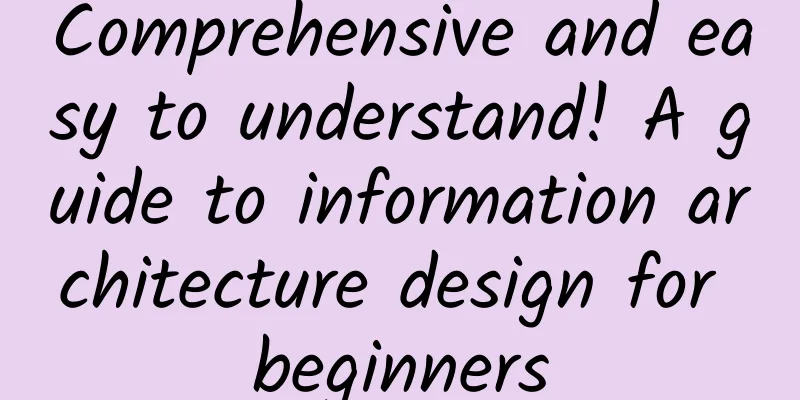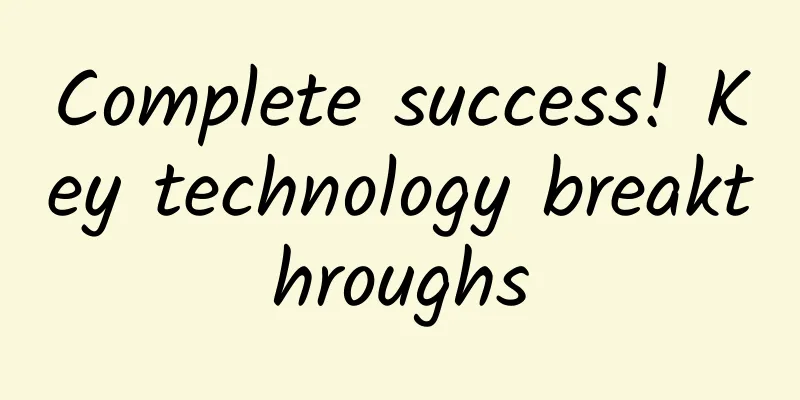Comprehensive and easy to understand! A guide to information architecture design for beginners

|
Many product designers are obsessed with the use of tools when drawing prototypes or designing UI. After receiving the requirements document, they are eager to start drawing, ignoring the role of information architecture design for the product. Information architecture is a very important part of a product as it is the skeleton of the product. It determines the layout and future development direction of a product as well as the user's initial impression and overall experience of a product. It is no exaggeration to say that a good product information architecture is half of the success of the product. So what exactly is a product’s information architecture? How should we design a product’s information architecture? How can we judge the quality of a product’s information architecture? Let’s continue reading: 1. The concept of information architecture Let’s look at an example: What facilities does a restaurant need? If you are the owner of a restaurant, how to arrange these facilities reasonably so that customers can feel comfortable dining is an information architecture process. It can make customers feel good about your restaurant, so that they will think of dining at your restaurant next time. In the process of arranging hotel facilities, we have to follow certain specifications, such as user habits or construction specifications. Precisely because we need to follow these specifications, we need an information architecture to reflect these. The more official explanation of information architecture is this: Information architecture design is the art and science of structuring, organizing, and classifying information so that it is easy for users to use and understand. Simply put, information architecture design is to make it easy for users to understand what your product is like. It allows them to use your product more smoothly and naturally. Just like when you enter a restaurant, you will feel that the door is the place to wait for food, and you should eat after entering. If you want to find the bathroom, you will definitely not go to the door, but go deeper. This is the benefit of information architecture: it makes it easier for users to use and understand similar products, making the product easier to accept. 2. Why do we need information architecture design? Why do online products need a reasonable information architecture? Let's take a look at the following three groups of app tab bar screenshots. Can you tell what type of app this is and how to use it just from the tab bar? Obviously, the first one is a shopping app, the second one is a photo social app, and the third one is the WeChat tab. Although the name of the homepage is WeChat, I believe that if the name is changed to "Chat", you can still recognize that this is the WeChat tab bar. From the tab bar at the bottom, you can roughly see what the product is used for, which is the role of information architecture. A reasonable information architecture can make the product very easy for users to understand, and can give users a simple understanding of the product at first glance, guiding them on what they can do with the product and what services the product provides. Let’s look at another set of counterexamples: These three tabs are very confusing. After looking at them for a long time, you may not know what these apps are used for or how to use them. If you confuse users, they will abandon your app in minutes. Therefore, the core goal of information architecture is to provide users with a better experience and achieve a higher retention rate. A product with good information architecture must follow the following two standards:
We use these two criteria to verify the information architecture of the three positive cases above:
Because your actual product features may be as follows:
3. How to design information architecture Reasonable information architecture design needs to consider 5 steps: Let me explain it step by step. 1. Understand users, scenarios, and habits First of all, your product is for users, so of course you need to understand your users as much as possible. Let’s first look at the next concept: “mental model”. A mental model is a script written in the mind about the development process of certain things through experience and learning. After experiencing or learning certain events, humans will draw some conclusions about the development and changes of things, and then condense these experiences into scripts one by one, just like writing a script. When repeated or similar things happen again, we will unconsciously apply these previously written scripts to predict the development and changes of things. A mental model is your prediction of the operation and development of things. To put it more clearly, how you "hope" things will develop is not a mental model, but how you "think" things will develop is your mental model. Let's say you've never seen an iPad before, and I just handed you one and told you that you can use it to read a book. Before you turn on your iPad and use it, you have a mental model of how you read on it. You imagine what a book looks like on the iPad screen, what you can do with it, like turning pages or using bookmarks, and how those things work. Even if you've never used an iPad before, you have a "mental model" of reading a book on it. The shape and operation of the mental model in your head depends on many factors. Users often use products with some of their previous habits of using apps; offline habits of doing the same thing, living habits, mental models, etc. It is necessary to consider what can be innovated and what are user habits, and to make innovations that are more acceptable to users without interfering with user habits. You need to consider 4 questions: What do users typically do with your product? What do users use your product for? To read news or to chat? Be sure to consider the core process of the user. Extract the basic form of information architecture from the core process. What do users care about most when using this type of product? The authenticity and effectiveness of consultation when using news apps, and the precise search and after-sales functions of shopping apps are what your users are concerned about, and this is a good breakthrough. What mindset do users have? If the product experience is related to the user's age and identity and is in line with the user's thinking pattern and mental model, the user will be more receptive to it. What similar products do users use? Similar products will also bring about some user habits, and catering to these habits will also allow users to quickly get started and accept the product. After understanding your user scenarios and usage habits, you will know how to make products that are in line with the user's mind and easy to accept. You don't need to worry about the lack of differentiation or competitiveness of your products. We can make innovations beyond the core process to make users feel that your products are both easy to use and somewhat different. 2. Understand the business The business here includes the demands raised by internal and external people who come into contact with the product, such as the company's operations, marketing, sales, BD, the company's external partners, etc. We also need to collect the needs of these people. For example, operations staff want to manage registered users more conveniently, sales staff want to add more advertising space, marketing staff require statistics on product downloads, registrations, and active users brought by different channels, partners need to establish accounts, exchange content, etc. In short, as long as the opinions of people related to the business, we should collect as many as possible before product design. Even if we can't do it, tell them the reason, otherwise they will complain after the product goes online. 3. Research the information architecture of competitors When making an app, we are faced with the situation of competing with countless competitors for users. At this time, it is very necessary to analyze competitors. We need to do a good job in core process functions on the premise of knowing ourselves and the enemy, and then think about how to make breakthroughs in differentiated functions. First, we need to organize the competitive product functions into a mind map: In fact, mind mapping is a relatively basic form of information architecture, but mind mapping alone is useless. We need to analyze the mind map. Take a networking app I made before as an example. I compared LinkedIn, Chitu and Maimai, and analyzed the mind maps of these four apps to find the similarities and differences: The commonality is what conforms to user usage habits. If the 3-5 products you research all do this, it is very likely that this is where user habits are generated. We need to follow this, which is the basis for gaining user favorability. When analyzing products, you will definitely find some differences between them, and these differences are your product's competitive points, and are also the reasons why others use your app instead of other apps. For example, all networking apps have social functions, but Maimai focuses more on workplace recruitment, live broadcasting, and other points that Internet professionals are more concerned about. In this way, the corresponding user groups will be more receptive to your approach, which will increase user stickiness. I believe that after you have sorted out the information architecture of competitors and summarized the commonalities and differences, you will have a clearer understanding of the information architecture of your product, and you will be more confident when designing your own product information architecture. But there is one more thing we can do, which is to classify the product functions we want to create. 4. Card Sorting Card classification is a method we often use in our work. It can verify and test our product information architecture on the user side. Card classification is a bottom-up organization method that allows users to classify and organize function cards and redefine the names of sets of related functions. To put it simply, prepare a bunch of cards, write the names of the functions you need to include on these cards, and then give them to users to classify and organize them, so as to understand how users think these functions should be combined and classified. It can help you understand how users identify these functions from the user's perspective, and you can also better understand what users think during the card classification process. The general steps and points to note for card sorting are as follows: The card sorting method will eventually produce a tree diagram like this: 5. Produce information architecture In fact, at this step, the rough outline of the information architecture has been formed. You can use Axure or software like Mindnode to sort out the information architecture. Next, you need to classify the importance of the information architecture, which can help sort out the priorities of product development in the early stages of product development and focus on solving the biggest pain points of users. When producing pages, you can also better control the size, hierarchy, and position relationship of page elements. ***You need to pay attention to the balance between layers and degrees: the number of layers should not exceed 5, otherwise it will be difficult to operate. Too many layers will increase the user's cognitive cost and make it difficult to find the content they are looking for. The degree here refers to the amount of information displayed on the same page. That’s all for this sharing. I believe you have learned the importance of information architecture and how to design it. I hope it will be helpful for your product and bring more retention and a good development direction to your product. If you have any questions or suggestions about information architecture, please leave a message. |
<<: Beginner's guide to UI design: iOS
>>: Google's next-generation Android Q will restrict the operation of apps below 6.0 system
Recommend
Can the "mermaid" in "Classic of Mountains and Seas" return to China?
The dugong, known as the "mermaid", is ...
Is Microsoft crazy? Win10 free upgrade has no time limit
Microsoft's Windows 10 operating system is no...
Douyin account or video account, which one is easier to become popular?
Throughout February, I was busy operating my two ...
8 years after Steve Jobs' death, is Tim Cook a qualified Apple CEO?
October 5, 2019, coincided with the 70th annivers...
Under what circumstances will the Douyin store deposit be deducted? Why was the Douyin store deposit deducted?
Since the establishment of Douyin store groups, m...
Does the human's "secret weapon" also have a "bug"? Monkeys, please don't blindly worship "walking upright"!
Primates, including humans, apes, monkeys, etc., ...
Many people died suddenly from pulmonary embolism while riding long-distance buses! How to diagnose and prevent it?
As the Spring Festival holiday comes to an end, w...
The story of a young bird falling: I know you want to pick it up, but don’t pick it up yet
Q: I picked up a baby bird. It can't fly yet,...
"Evil spirit possession" or brain disease? There are so many misunderstandings about epilepsy
The word epilepsy comes from the Greek epilambane...
A brief analysis of the key points of Double 11 project operation and promotion!
When it comes to Double 11, I believe everyone is...
Crunchbase: Health and biotech investments to exceed $120 billion in 2021
Investments in biotech and healthcare have boomed...
The train to Shangri-La is coming! The Lixiang section of the Yunnan-Tibet Railway is about to open. What are the "check-in points" along the way?
It is reported that the Lijiang-Xiangjiang sectio...
Where is the "food" for super-hard "nuclear" technology? Travel all over the mountains and rivers to add "uranium" to China!
▲Cover figure of "Scientific Chinese": ...
How did Zhang Xiaolong build the huge business empire of WeChat?
WeChat's business strategy has always been co...









